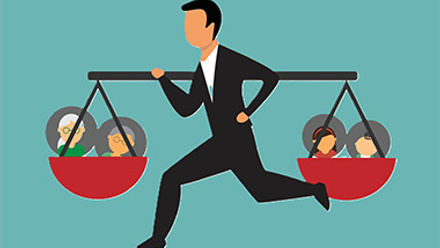Building stronger resilience: the psychology of mental wellbeing
Resilience is the capacity to cope mentally and emotionally with a crisis and be able to recover quickly from difficulties.
While some people might appear to be more naturally resilient than others, it’s a skill that needs to be cultivated and nurtured. Like riding a bike, the more you practice it, the better you’ll be.
Businesses and their employees have faced some tough times in recent years, with the global pandemic contributing to changes in the way we work.
Remote working arrangements, for example, have made it much harder for employers to assess the wellbeing of an individual, meaning that mental health struggles can go unnoticed.
According to a global 2023 study by Gallup, a workplace consulting and research company, workplace stress is increasing. This has a knock-on effect regularly associated with physical and mental health problems as well as low productivity levels.
Statistics show that 51% of long-term absence is due to stress, depression or anxiety, and 61% of workers report that they feel exhausted at the end of most working days.
While there are many contributing factors that are causing this mental health epidemic within the workforce, supporting employee resilience can help create a healthier environment.
Here are five effective ways you can do this:
1. Promote an open culture
A culture where employees feel comfortable talking with their managers and peers will provide reassurance that they have a support network in place. When challenges arise, an individual can speak openly about the issues they are facing and know that they will be listened to.
2. Understand stress triggers
Every employee is different and therefore, should be treated in the appropriate way.
For example, an employee might be having a hard time in their personal life and its impacting the quality of their work. Rather than punish them, which can trigger further stress and anxiety, it's best to put a support plan in place.
3. Introduce support pathways
In-house methods such as a ‘buddy’ system can be used to support employees, however, it’s important to consider external pathways such as an employee assistance programme (EAP).
The right EAP provider will offer assistance 365 days a year and provide professional consultation that is bespoke to your employees needs.
4. Arrange training that builds resilience
Resilience training can equip individuals with the skills they need to adapt and grow in even the most challenging situations. This can be part of a long-term mental health strategy and be open to all employees.
Specialised training can be put in place for managers to help them identify and support employees who are struggling. Your EAP might also be able to support with this.
5. Lead by example
Good habits, a positive attitude, frequent breaks and respect for others mental health, means that you can help shape a healthy workplace culture by inspiring and motivating others to do the same.
If a crisis should happen, whether that’s with the business or with an individual, acting in the appropriate manner is crucial to avoid spreading further tension and anxiety.
Numerous actions can be taken to support mental health in the workplace, and building employee resilience should be done in tandem with other methods for it to make a more meaningful impact.
A mental health programme that combines both in-house and external support will ensure that your employee’s mental wellbeing is being cared for in the right way.
Remember, resilience is a skill that is built over time. Your priority should be making a long-term investment in mental wellbeing rather than implementing one-off initiatives.
Supplied by REBA Associate Member, BHSF
BHSF is a market-leading health and wellbeing provider.








